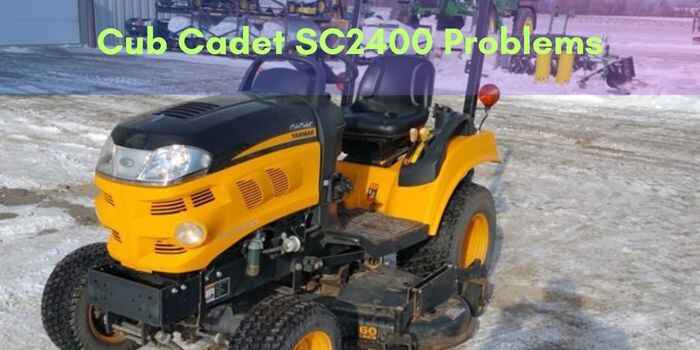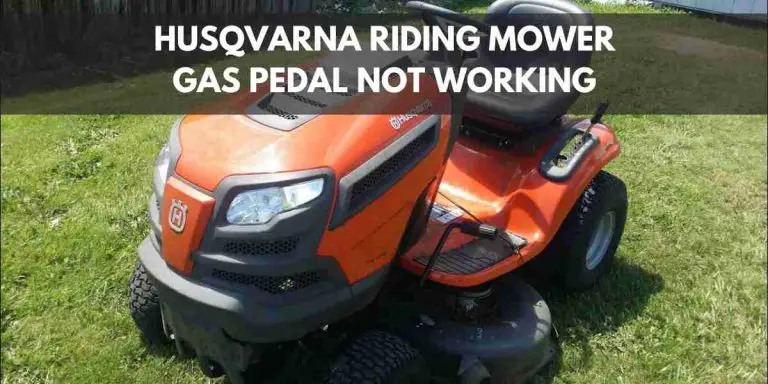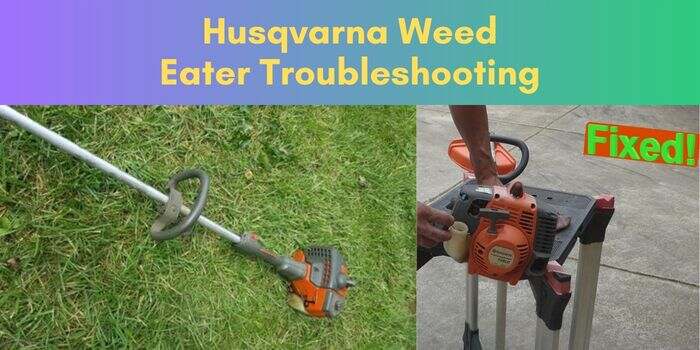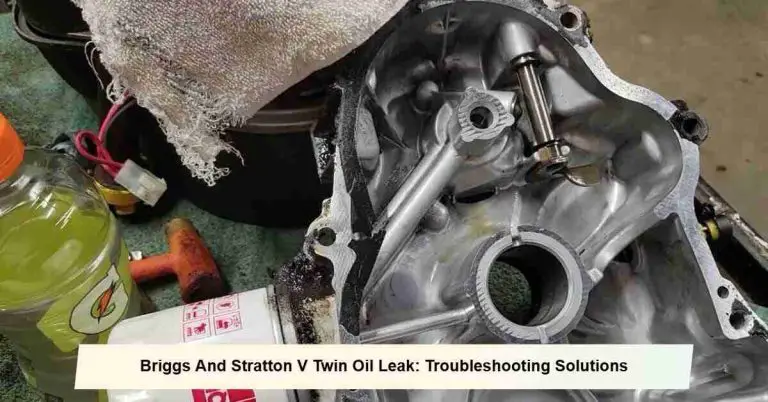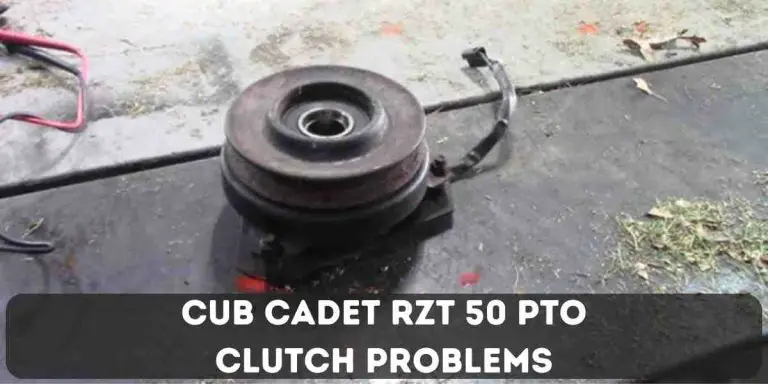Cub Cadet Rzt 50 Hydrostatic Transmission Problems: Troubleshoot and Conquer!
Cub Cadet Rzt 50 hydrostatic transmission problems can be resolved by diagnosing the issue and repairing or replacing any faulty components. Welcome to our guide on addressing common hydrostatic transmission problems with the Cub Cadet Rzt 50.
Many owners may experience issues with their hydrostatic transmissions, such as loss of power, difficulty shifting gears, or leaks. We will discuss how to troubleshoot and resolve these problems, ensuring your mower operates smoothly and efficiently. By following our step-by-step instructions, you can diagnose the exact issue and proceed with the necessary repairs or replacements.
So, let’s get started and get your Cub Cadet Rzt 50 back in optimal working condition.
How Does The Hydrostatic Transmission System Work?
The hydrostatic transmission system is an essential component of the Cub Cadet RZT 50 and plays a vital role in ensuring smooth operation and efficient power transfer. Understanding how this system works is crucial for diagnosing and resolving any problems that may arise.
Explanation of the basic functioning
The hydrostatic transmission system in the Cub Cadet RZT 50 operates on a simple principle – it utilizes hydraulic pressure to transmit power from the engine to the wheels. Unlike traditional manual transmissions that rely on gears and clutches, the hydrostatic system employs a hydraulic pump and motor to control the speed and direction of the mower.
Here’s a breakdown of how it works:
- The engine powers the hydraulic pump, which is responsible for converting mechanical energy into hydraulic pressure.
- The hydraulic fluid, stored in a reservoir, is pressurized by the pump and then transmitted to the hydraulic motor.
- The hydraulic motor converts the hydraulic pressure back into mechanical energy, which drives the wheels of the Cub Cadet RZT 50.
This fluid-based power transfer system provides several advantages over conventional transmissions. It offers seamless speed control, allowing for easy adjustments while operating the mower. Moreover, the absence of gears eliminates the need for shifting and reduces overall component wear and tear.
Role of hydraulic fluid
Hydraulic fluid plays a pivotal role in the hydrostatic transmission system of the Cub Cadet RZT 50. It acts as a medium for power transfer and ensures smooth operation of the hydraulic components. Here are some key points highlighting its significance:
- Viscosity: Hydraulic fluid must have the appropriate viscosity to ensure efficient energy transmission. It needs to provide enough resistance to prevent slippage but not so much that it restricts the flow of hydraulic power.
- Lubrication: The hydraulic fluid not only serves as an energy transfer medium but also lubricates and cools the hydraulic pump and motor. This helps to reduce friction and prevent overheating of these critical components.
- Contamination Control: Contaminants can severely impact the performance of the hydrostatic transmission system. The hydraulic fluid acts as a barrier, preventing particulate matter and debris from entering the system and causing damage.
- Maintenance: Regular maintenance, including fluid checks and changes, is crucial to keeping the hydrostatic transmission system in optimal condition. Maintaining the proper fluid levels and cleanliness is key to preventing potential problems.
Ensuring that the hydraulic fluid is of the recommended type and regularly monitoring its condition is vital for the smooth operation and longevity of the Cub Cadet RZT 50’s hydrostatic transmission system.
Common Issues With Cub Cadet Rzt 50 Hydrostatic Transmission
The Cub Cadet RZT 50 is a popular ride-on mower that delivers power, performance, and precision. However, like any machine, it is not immune to problems. One area where users often encounter issues is the hydrostatic transmission system. In this section, we will delve into the common problems faced by users when it comes to the Cub Cadet RZT 50’s hydrostatic transmission. By understanding these issues, you will be better equipped to troubleshoot and resolve any problems that may arise.
Overview of Common Problems
Before we delve into specific issues, it is important to have a general understanding of the common problems that users face with the Cub Cadet RZT 50’s hydrostatic transmission. Here is an overview of these issues:
- Loss of power and speed
- Fluid leaks
- Inconsistent or jerky movement
- Difficulty engaging or disengaging
- Noise or vibration
Analysis of Specific Problems Faced by Users
Loss of Power and Speed
One of the most frustrating issues that users may encounter with the Cub Cadet RZT 50’s hydrostatic transmission is a sudden loss of power and speed. This issue can stem from a variety of causes, including:
- Low fluid levels
- Worn drive belt or pulleys
- Incorrect transmission adjustment
- Malfunctioning control linkage
To address this problem, start by checking the fluid levels and ensuring they are within the recommended range. If the fluid levels are low, replenish them according to the manufacturer’s instructions. If the problem persists, it may be necessary to inspect and replace the drive belt or pulleys. Adjusting the transmission and checking for any issues with the control linkage can also help resolve this problem.
Fluid Leaks
Fluid leaks can occur in the hydrostatic transmission system of the Cub Cadet RZT 50, leading to a reduction in performance and potential damage to the transmission components. Common causes of fluid leaks include:
- Loose or damaged fittings
- Worn or cracked seals
- Incorrectly installed gaskets
If you notice fluid leaks, it is crucial to identify the source and address the issue promptly. Check all fittings and connections to ensure they are tightened securely. Inspect the seals and gaskets for any signs of wear or damage, and replace them if necessary. By addressing fluid leaks early on, you can prevent more significant damage to the transmission system.
Inconsistent or Jerky Movement
Another issue that users may encounter is inconsistent or jerky movement of the Cub Cadet RZT 50. This problem can make mowing tasks challenging and affect the overall quality of the cut. Some common causes of inconsistent or jerky movement include:
- Improperly adjusted control arms
- Blocked or clogged cooling fins
- Worn or damaged internal components
To resolve this issue, start by inspecting the control arms and ensuring they are properly adjusted. Clear any debris or obstructions from the cooling fins to prevent overheating and loss of performance. If the issue persists, it may be necessary to have a professional technician inspect and potentially replace any worn or damaged internal components.
Difficulty Engaging or Disengaging
Sometimes, users may face challenges when trying to engage or disengage the Cub Cadet RZT 50’s hydrostatic transmission. This problem can be caused by various factors, including:
- Worn or damaged engagement lever or cable
- Faulty electric clutch
- Malfunctioning power take-off switch
If you encounter difficulties with engagement or disengagement, start by examining the engagement lever and cable for any signs of wear or damage. Replace them if necessary. Check the electric clutch and power take-off switch for any faults or malfunctions. If the issue persists, it is recommended to seek assistance from a qualified technician.
Noise or Vibration
Noise or vibration in the hydrostatic transmission can be indicative of potential problems. Some common causes of these issues include:
- Loose or worn components
- Unbalanced drive pulleys
- Internal transmission damage
If you notice unusual noise or vibration, inspect the transmission components for any signs of looseness or wear. Tighten or replace components as necessary. Check the drive pulleys for balance and make adjustments if needed. If the noise or vibration persists, it is advisable to consult a professional for a thorough inspection and potential repairs.
Inspecting And Maintaining The Hydrostatic Transmission
When it comes to maintaining your Cub Cadet Rzt 50 hydrostatic transmission, regular inspection and maintenance are of utmost importance. The hydrostatic transmission system is a vital component that allows for smooth and efficient operation of your lawn mower. Regularly inspecting and maintaining this system will help prevent potential problems and ensure your lawn mower continues to perform at its best.
Importance of Regular Inspection and Maintenance
Regular inspection and maintenance of the hydrostatic transmission system is crucial to maintaining the overall functionality of your Cub Cadet Rzt 50. By taking the time to inspect and maintain this system, you can:
- Prolong the lifespan of your lawn mower
- Prevent costly repairs
- Ensure optimal performance
- Avoid downtime due to transmission issues
Steps to Inspect the Hydrostatic Transmission System
Inspecting the hydrostatic transmission system involves a few key steps to ensure its proper functioning. By following these steps, you can identify any potential problems and take the necessary actions to address them:
- Start by positioning your lawn mower on a flat and level surface to ensure accurate readings.
- Inspect the transmission oil level. Locate the transmission oil reservoir and remove the dipstick. Wipe it clean, reinsert it fully, and then remove it again to check the oil level. If the oil level is below the recommended range, add the appropriate transmission oil. Refer to your owner’s manual for the correct type of oil and capacity.
- Check the transmission oil for any signs of contamination or debris. Clean transmission oil should be clear and free from contaminants. If you notice any discoloration, particles, or a burnt smell, it may indicate a problem with the transmission and further inspection or maintenance may be required.
- Inspect the transmission drive belt for any signs of wear, damage, or looseness. A damaged or loose drive belt can lead to poor transmission performance. Replace or adjust the drive belt as needed.
- Examine the transmission cooling system, if applicable. Ensure that the cooling fins on the transmission are clean and free from debris. An obstructed cooling system can lead to overheating and transmission issues. Use compressed air or a soft brush to clean the fins if necessary.
By following these steps, you can effectively inspect your Cub Cadet Rzt 50 hydrostatic transmission system and address any potential problems early on. Regular inspection and maintenance will help keep your lawn mower running smoothly and extend its lifespan. Remember to always refer to your owner’s manual for specific instructions and guidelines regarding the inspection and maintenance of your hydrostatic transmission system.
Identifying And Resolving Fluid-Related Problems
Identifying and resolving fluid-related problems is crucial to maintaining the optimal performance of Cub Cadet Rzt 50’s hydrostatic transmission. The hydrostatic transmission system relies on hydraulic fluid to power its operation, and any issues with the fluid can lead to decreased efficiency and potential damage to the transmission components. In this section, we will focus on the significance of proper hydraulic fluid levels, how to check for fluid leakage, and the steps to change or replace the hydraulic fluid.
Significance of proper hydraulic fluid levels
Proper hydraulic fluid levels are vital for the smooth operation and longevity of the Cub Cadet Rzt 50’s hydrostatic transmission. Insufficient fluid can lead to excessive friction and heat, resulting in increased wear on the transmission parts and a decline in performance. On the other hand, overfilled fluid levels can cause foaming, which reduces the fluid’s ability to transfer power effectively. To ensure optimal functioning, it is essential to maintain the hydraulic fluid at the recommended level.
How to check for fluid leakage
Regularly checking for fluid leakage is essential to catch any problems early on and prevent further damage to the hydrostatic transmission system. Here is a simple step-by-step process to check for fluid leakage:
- Start by parking the Cub Cadet Rzt 50 on a flat surface and engage the parking brake.
- Locate the hydraulic fluid reservoir, which is typically positioned near the transmission.
- Carefully inspect the reservoir and surrounding areas for any signs of fluid leakage. Look for puddles, wet spots, or oil stains.
- If you notice any indications of leakage, identify the source of the leak by tracing the fluid trail. Common areas of leakage include damaged hoses, loose fittings, or worn seals.
- Address the leakage issue promptly by tightening fittings, replacing damaged components, or sealing the affected areas.
- After resolving the leakage problem, clean any spilled hydraulic fluid and ensure the reservoir is filled to the recommended level.
Steps to change/replace hydraulic fluid
Regularly changing or replacing the hydraulic fluid is crucial to maintain the optimal performance and longevity of the hydrostatic transmission. Here are the steps to follow for a successful fluid change:
- First, make sure the Cub Cadet Rzt is parked on a flat surface and the parking brake is engaged.
- Locate the hydraulic fluid reservoir and position a drain pan underneath it to catch the old fluid.
- Remove the fill plug from the reservoir to facilitate smooth drainage.
- Open the drain plug, allowing the old fluid to drain completely into the pan.
- Once the draining is complete, close the drain plug securely.
- Add the appropriate hydraulic fluid, following the manufacturer’s recommendations, through the fill plug opening. Use a funnel if necessary to avoid spills.
- Monitor the fluid level and stop adding when it reaches the recommended level.
- Finally, replace the fill plug tightly, ensuring a secure seal.
By adhering to these steps and regularly maintaining the hydraulic fluid, you can prevent and resolve fluid-related problems in the Cub Cadet Rzt 50’s hydrostatic transmission, ensuring optimal performance and extending the lifespan of the mower.
Addressing Drive Belt Issues
If you own a Cub Cadet Rzt 50 with a hydrostatic transmission, it’s crucial to address any drive belt issues promptly. The drive belt plays a vital role in the hydrostatic transmission system, and if it malfunctions, it can lead to reduced performance and potential damage to the mower. In this section, we will discuss the role of the drive belt in the hydrostatic transmission system and explore methods to diagnose and fix drive belt problems.
Role of Drive Belt in the Hydrostatic Transmission System
The drive belt is a critical component in the hydrostatic transmission system of the Cub Cadet Rzt 50. It connects the engine to the transmission pulley, transferring power and ensuring smooth operation. The drive belt enables the hydrostatic transmission to efficiently control the speed and direction of the mower.
When the engine is running, it turns the drive belt, which in turn rotates the transmission pulley. The varying position of the belt on the pulley determines the speed and direction of the mower. Therefore, any issues with the drive belt can directly impact the performance of the hydrostatic transmission system, resulting in problems such as loss of power, erratic movement, or even complete failure.
Methods to Diagnose and Fix Drive Belt Problems
If you suspect that your Cub Cadet Rzt 50 is experiencing drive belt problems, it’s crucial to diagnose and address the issue promptly. Here are a few methods to help you identify and fix drive belt problems:
- Visual Inspection: Start by visually inspecting the drive belt for any signs of wear, damage, or misalignment. Look for cracks, fraying, or uneven wear on the belt surface. Additionally, ensure that the belt is correctly aligned on the pulley system.
- Tension Adjustment: Proper tension is crucial for the optimal performance of the drive belt. If the belt is too loose or too tight, it can cause slipping, reduced power, or even belt breakage. Refer to the owner’s manual for instructions on how to adjust the tension and ensure it is within the recommended specifications.
- Belt Replacement: If the drive belt shows significant signs of wear or damage, it’s essential to replace it with a new one. Consult the owner’s manual or contact a professional for guidance on the correct belt size and installation process. Remember to follow the recommended guidelines for belt replacement intervals to prevent future issues.
- Pulley Inspection: Inspect the transmission pulley and any associated pulleys for any damage or wear. Damaged pulleys can cause the belt to slip or wear out prematurely. If necessary, replace the pulleys to ensure optimal performance of the drive belt.
By following these methods, you can diagnose and fix drive belt problems in your Cub Cadet Rzt 50, ensuring smooth operation and preventing further damage to the hydrostatic transmission system. Regular maintenance and prompt attention to drive belt issues are essential to keep your mower running efficiently.
Solving Loss Of Power And Performance Issues
When it comes to the quality and efficiency of your Cub Cadet Rzt 50 Hydrostatic Transmission, loss of power and performance issues can be incredibly frustrating. These problems can cause a decrease in productivity and hinder the overall efficiency of your lawn tractor. Luckily, there are several common reasons for these issues, and steps you can take to troubleshoot and resolve them. In this article, we will explore the reasons behind the loss of power and performance, and guide you through the process of troubleshooting and solving these problems.
<Reasons for loss of power and performance>
If you’ve noticed a loss of power and performance in your Cub Cadet Rzt 50, there are a few common culprits that could be at the root of the issue. By understanding these reasons, you can take appropriate steps to diagnose and resolve the problem:
<Steps to troubleshoot and resolve these problems>
Resolving the loss of power and performance issues with your Cub Cadet Rzt 50 can be achieved through a systematic troubleshooting process. Follow these steps to identify and address the problem:
- Inspect the Air Filter: A dirty or clogged air filter can restrict airflow to the engine, leading to a decrease in power and performance. Remove the air filter and check for any dirt or debris. Clean or replace the air filter as needed.
- Check the Fuel System: A malfunctioning fuel system can significantly impact the performance of your lawn tractor. Start by ensuring that the fuel tank is adequately filled and that the fuel is fresh. Next, inspect the fuel filter for any clogs or blockages. If necessary, clean or replace the fuel filter. Additionally, check the fuel lines for any damage or leaks and address them accordingly.
- Examine the Spark Plugs: Faulty or dirty spark plugs can lead to a loss of power and performance. Remove the spark plugs and inspect them. If they are covered in carbon deposits or damaged, replace them with new ones. It’s also essential to check the spark plug gaps and adjust them to the manufacturer’s specifications.
- Inspect the Drive Belt: A worn-out or loose drive belt can cause power and performance issues in your Cub Cadet Rzt 50. Carefully examine the drive belt for signs of wear or damage. If necessary, replace the drive belt following the manufacturer’s instructions.
- Check the Transmission Fluid: Insufficient or degraded transmission fluid can lead to a loss of power and performance. Locate the transmission fluid dipstick and check the fluid level and condition. If required, add or replace the transmission fluid according to the recommended specifications.
By thoroughly examining and addressing these potential reasons for loss of power and performance, you can ensure that your Cub Cadet Rzt 50 Hydrostatic Transmission operates at its optimum level. Regular maintenance and timely troubleshooting are essential to keep your lawn tractor running smoothly and efficiently.
Adjusting The Transmission Control Linkage
One of the key elements in ensuring smooth operation of your Cub Cadet Rzt 50 is proper adjustment of the transmission control linkage. When this linkage is not set up correctly, it can lead to various hydrostatic transmission problems, such as difficulty shifting gears, jerky movements, or even complete failure of the transmission system. In this section, we will discuss the importance of proper adjustment and provide step-by-step instructions on how to adjust the transmission control linkage effectively.
Importance of Proper Adjustment
Proper adjustment of the transmission control linkage is crucial for maintaining the overall performance and durability of your Cub Cadet Rzt 50. When the linkage is not correctly set, it can result in excessive wear and tear on the transmission components, leading to premature failure. It can also cause the transmission to shift gears improperly, causing jerky movements and decreased maneuverability of the mower. By ensuring that the transmission control linkage is correctly adjusted, you can extend the lifespan of your hydrostatic transmission and enjoy smooth operation of your Cub Cadet Rzt 50.
Steps to Adjust the Transmission Control Linkage
Adjusting the transmission control linkage for your Cub Cadet Rzt 50 is a relatively simple process that can be done with a few basic tools. Here are the step-by-step instructions:
- Start by parking your Cub Cadet Rzt 50 on a flat, level surface to ensure stability during the adjustment process.
- Locate the adjustment nut on the transmission control linkage. This nut is usually located near the hydrostatic transmission itself and may require you to remove any protective covers to access it.
- Loosen the adjustment nut using a wrench or socket set. Make sure not to remove the nut completely, as you will be adjusting the linkage using this nut.
- Now, locate the adjustment bolt on the transmission itself. This bolt is used to fine-tune the position of the transmission control linkage.
- While keeping an eye on the position of the control linkage, turn the adjustment bolt clockwise to tighten or counterclockwise to loosen.
- Make small adjustments to the bolt and observe the movement of the linkage. The goal is to achieve smooth engagement and disengagement of the transmission gears.
- Once you have achieved the desired smoothness, tighten the adjustment nut to secure the position of the control linkage.
- Test the operation of the hydrostatic transmission by shifting through different gears and observing the mower’s movements.
- Repeat the adjustment process if necessary until the transmission operates smoothly and responsively.
By following these steps and ensuring proper adjustment of the transmission control linkage, you can resolve many hydrostatic transmission problems on your Cub Cadet Rzt 50. Remember to always consult your mower’s user manual for specific instructions and safety precautions when making any adjustments or repairs.
Replacing The Hydrostatic Transmission
Instances when replacement is necessary
If you own a Cub Cadet Rzt 50 with hydrostatic transmission, there may come a time when you encounter problems. While the hydrostatic transmission in these mowers is generally reliable, there are instances when replacement becomes necessary. Here are some situations that may require you to replace the hydrostatic transmission:
- Severe damage: If the hydrostatic transmission experiences severe damage due to a collision or a mechanical failure, replacement may be the only feasible solution. Continuing to use a damaged transmission can adversely affect the performance and lifespan of your Cub Cadet Rzt 50.
- Excessive wear and tear: Over time, the hydrostatic transmission can wear out due to constant usage and exposure to different elements. If you notice a significant decline in the mower’s performance, such as reduced speed or difficulty in changing gears, it may be an indication that the transmission is worn out and requires replacement.
- Leaking fluid: A common problem in hydrostatic transmissions is fluid leakage. If you observe fluid leaking from the transmission, be it from the vent, seals, or other areas, it’s a clear sign that there is a problem. In such cases, the best course of action is often to replace the transmission to prevent further damage and ensure optimal performance.
- Cost vs. Repair: In some instances, the cost of repairing a faulty hydrostatic transmission may outweigh the cost of replacing it. If the transmission is beyond repair or if the repair costs are excessively high, it can be more cost-effective and practical to invest in a new transmission.
Steps involved in replacing the hydrostatic transmission
If you’ve determined that replacing the hydrostatic transmission is necessary for your Cub Cadet Rzt 50, here are the general steps involved in the process:
- Prepare for the replacement: Ensure your mower is in a safe and stable position. This may involve raising the front and rear of the machine using jacks or blocks. Remove the battery cables and battery, and disconnect any additional components that may hinder the removal of the old transmission.
- Remove the old transmission: Start by draining the fluid in the old transmission and properly disposing of it. Then, remove the cutting deck, belt, and any other attachments that may be in the way. Carefully disconnect the hydrostatic hoses and linkages from the transmission. Finally, unbolt the transmission from the mower’s frame and remove it.
- Install the new transmission: Carefully position the new hydrostatic transmission onto the mower’s frame and secure it with the appropriate bolts. Reconnect the hydrostatic hoses and linkages, making sure they are properly aligned and tightened. Reinstall any attachments that were removed earlier, such as the cutting deck and belt.
- Refill and test: Fill the new transmission with the recommended amount and type of fluid. Reconnect the battery and cables. Once everything is in place, start the engine and test the mower’s performance. Verify that the new transmission operates smoothly, allowing you to change gears and achieve the desired speed.
Replacing the hydrostatic transmission in your Cub Cadet Rzt 50 may seem like a daunting task, but by following these steps and taking the appropriate precautions, you can ensure a successful replacement. If you are unsure or inexperienced with mower maintenance, it’s always advisable to seek professional assistance to avoid any potential mishaps or complications.
Seeking Professional Help And Maintenance Tips
When it comes to owning a Cub Cadet Rzt 50 with a hydrostatic transmission system, it’s important to be aware of potential problems that may arise. While this system provides excellent performance and maneuverability, it can sometimes experience issues that require professional assistance. In this section, we will explore when to consult a professional and provide maintenance tips to help you keep your hydrostatic transmission system running smoothly.
When to Consult a Professional
If you notice any of the following signs, it’s recommended to seek professional help for your Cub Cadet Rzt 50 hydrostatic transmission:
- Unusual noises: If you hear grinding, whining, or clunking sounds coming from the transmission, it could indicate internal damage or worn-out components. A professional technician can diagnose and address the issue promptly.
- Lack of power: If you feel a decrease in power or notice a loss of speed, it may be a sign of an underlying problem with the transmission. Professional expertise is essential to identify and resolve the cause.
- Fluid leakage: Any visible signs of fluid leakage should be taken seriously. A professional can assess the source of the leak and determine the necessary repairs or replacements.
- Erratic behavior: If your Cub Cadet Rzt 50 hydrostatic transmission system exhibits erratic behavior such as sudden jerking or slipping, it’s best to consult a professional technician. They can diagnose the issue accurately and recommend the appropriate course of action.
Tips for Maintaining the Hydrostatic Transmission System
To ensure the longevity and performance of your hydrostatic transmission system, it’s crucial to follow these maintenance tips:
- Regular fluid checks: Check the fluid level of the transmission frequently, following the manufacturer’s guidelines. Low or dirty fluid can lead to transmission problems. If necessary, top up or replace the fluid accordingly.
- Fluid filter maintenance: The fluid filter is responsible for capturing contaminants and preventing them from entering the transmission. Regularly inspect and clean or replace the filter, as recommended by the manufacturer, to maintain optimal performance.
- Proper cooling: Overheating can have a detrimental impact on the hydrostatic transmission. Ensure that the cooling fins and air passages are clean and free from debris. Regularly check the cooling fan’s functionality to prevent overheating issues.
- Smooth operation: Operate the hydrostatic transmission system smoothly, avoiding abrupt changes in speed or excessive load. Smooth acceleration and deceleration reduce stress on the system components, extending their lifespan.
- Periodic maintenance checks: Schedule regular maintenance checks with a professional technician who specializes in Cub Cadet equipment. They can inspect and service the hydrostatic transmission system, detecting and addressing any potential problems before they escalate.
By following these maintenance tips and seeking professional help when needed, you can ensure that your Cub Cadet Rzt 50 hydrostatic transmission system remains in optimal condition, providing you with a reliable and smooth lawn mowing experience.
Frequently Asked Questions On Cub Cadet Rzt 50 Hydrostatic Transmission Problems
Can A Cub Cadet Rzt 50 Hydrostatic Transmission Be Repaired?
Yes, the hydrostatic transmission in a Cub Cadet RZT 50 can be repaired. It is recommended to take the mower to an authorized Cub Cadet service center for diagnosis and repair. They have the expertise and knowledge to fix any transmission problems and ensure your mower is running smoothly.
How Much Does It Cost To Repair A Hydrostatic Transmission In A Cub Cadet Rzt 50?
The cost to repair a hydrostatic transmission in a Cub Cadet RZT 50 can vary depending on the extent of the damage and the specific parts needed for the repair. On average, you can expect to pay around $300 to $800 for transmission repairs.
It is best to get a quote from a certified technician to get an accurate estimate.
What Are The Signs Of A Failing Hydrostatic Transmission On A Cub Cadet Rzt 50?
Some signs of a failing hydrostatic transmission on a Cub Cadet RZT 50 include difficulty shifting gears, slipping or jerking motions, loss of power, and strange noises coming from the transmission. If you notice any of these symptoms, it is important to have your mower inspected and repaired by a qualified technician to prevent further damage.
Conclusion
To sum up, keeping your Cub Cadet Rzt 50 in good working condition is crucial to avoid hydrostatic transmission problems. Regular maintenance, like checking the fluid levels and ensuring proper belt tension, can go a long way in preventing issues.
Additionally, addressing any early signs of transmission problems promptly can save you from costly repairs down the line. By following these simple steps, you can ensure a smooth and reliable mowing experience with your Cub Cadet Rzt 50.

